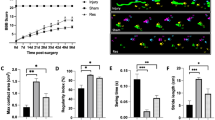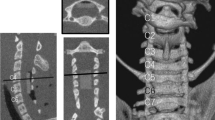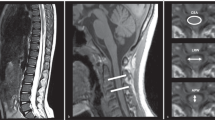Abstract
Aim:
To investigate the neuroprotective effect of glycyrrhizin (Gly) against the ischemic injury of rat spinal cord and the possible role of the nuclear protein high-mobility group box 1 (HMGB1) in the process.
Methods:
Male Sprague-Dawley rats were subjected to 45 min aortic occlusion to induce transient lumbar spinal cord ischemia. The motor functions of the animals were assessed according to the modified Tarlov scale. The animals were sacrificed 72 h after reperfusion and the lumbar spinal cord segment (L2–L4) was taken out for histopathological examination and Western blotting analysis. Serum inflammatory cytokine and HMGB1 levels were analyzed using ELISA.
Results:
Gly (6 mg/kg) administered intravenously 30 min before inducing the transient lumbar spinal cord ischemia significantly improved the hind-limb motor function scores, and reduced the number of apoptotic neurons, which was accompanied by reduced levels of tumor necrosis factor-α (TNF-α), interleukin-1β (IL-1β) and interleukin-6 (IL-6) in the plasma and injured spinal cord. Moreover, the serum HMGB1 level correlated well with the serum TNF-α, IL-1β and IL-6 levels during the time period of reperfusion.
Conclusion:
The results suggest that Gly can attenuate the transient spinal cord ischemic injury in rats via reducing inflammatory cytokines and inhibiting the release of HMGB1.
Similar content being viewed by others
Log in or create a free account to read this content
Gain free access to this article, as well as selected content from this journal and more on nature.com
or
References
Ronald AK, Marc ES, David MM . Anesthetic consideration for descending thoracic aortic aneurysm repair. Semin Cardiothorac Vasc Anesth 2007; 11: 205–23.
Tabayashi K . Spinal cord protection during thoracoabdominal aneurysm repair. Surg Today 2005; 35: 1–6.
Conrad MF, Ergul EA, Patel VI, Cambria MR, Lamuraglia GM, Simon M, et al. Evolution of operative strategies in open thoracoabdominal aneurysm repair. J Vasc Surg 2011; 53: 1195–201.
Danielisova V, Chavko M . Comparative effects of the N-methyl-D-aspartate antagonist MK-801 and the calcium channel blocker KB-2796 on neurologic and metabolic recovery after spinal cord ischemia. Exp Neurol 1998; 149: 203–8.
Agee JM, Flanagan T, Blackbourne LH, Kron IL, Tribble CG . Reducing postischemic paraplegia using conjugated superoxide dismutase. Ann Thorac Surg 1991; 51: 911–5.
Hirose K, Okajima K, Taoka Y, Uchiba M, Tagami H, Nakano K, et al. Activated protein C reduces the ischemia/reperfusion-induced spinal cord injury in rats by inhibiting neutrophil activation. Ann Surg 2000; 232: 272–80.
Klebanoff SJ, Vadas MA, Harlan JM, Sparks LH, Gamble JR, Agosti JM, et al. Stimulation of neutrophils by tumor necrosis factor. J Immunol 1986; 136: 4220–5.
Taoka Y, Okajima K, Murakami K, Johno M, Naruo M . Role of neutrophil elastase in compression-induced spinal cord injury in rats. Brain Res 1998; 799: 264–9.
Muller S, Ronfani L, Bianchi ME . Regulated expression and subcellular localization of HMGB1, a chromatin protein with a cytokine function. J Intern Med 2004; 255: 332–43.
Dumitriu IE, Baruah P, Manfredi AA, Bianchi ME, Rovere-Querini P . HMGB1: guiding immunity from within. Trends Immunol 2005; 26: 381–7.
Faraco G, Fossati S, Bianchi ME, Patrone M, Pedrazzi M, Sparatore B, et al. High mobility group box 1 protein is released by neural cells upon different stresses and worsens ischemic neurodegeneration in vitro and in vivo. J Neurochem 2007; 103: 590–603.
Kim JB, Lim CM, Yu YM, Lee JK . Induction and subcellular localization of high-mobility group box-1 (HMGB1) in the postischemic rat brain. J Neurosci Res 2008; 86: 1125–31.
Kim JB, Sig Choi J, Yu YM, Nam K, Piao CS, Kim SW, et al. HMGB1, a novel cytokine-like mediator linking acute neuronal death and delayed neuroinflammation in the postischemic brain. J Neurosci 2006; 26: 6413–21.
Arase Y, Ikeda K, Murashima N, Chayama K, Tsubota A, Koida I, et al. The long term efficacy of glycyrrhizin in chronic hepatitis C patients. Cancer 1997; 79: 1494–500.
Mollica L, De Marchis F, Spitaleri A, Dallacosta C, Pennacchini D, Zamai M, et al. Glycyrrhizin binds to high-mobility group box 1 protein and inhibits its cytokine activities. Chem Biol 2007; 14: 431–41.
van Rossum TG, Vulto AG, Hop WC, Schalm SW . Glycyrrhizin-induced reduction of ALT in European patients with chronic hepatitis C. Am J Gastroenterol 2001; 96: 2432–7.
Akgun S, Tekeli A, Kurtkaya O, Civelek A, Isbir SC, Ak K, et al. Neuroprotective effects of FK-506, L-carnitine and azathioprine on spinal cord ischemia-reperfusion injury. Eur J Cardiothorac Surg 2004; 25: 105–10.
Nakayama T, Harada N, Asano M, Nomura N, Saito T, Mishima A, et al. Atrial natriuretic peptide reduces ischemia/reperfusion-induced spinal cord injury in rats by enhancing sensory neuron activation. J Pharmacol Exp Ther 2007; 322: 582–90.
Fiane AE, Videm V, Lingaas PS, Heggelund L, Nielsen EW, Geiran OR, et al. Mechanism of complement activation and its role in the inflammatory response after thoracoabdominal aortic aneurysm repair. Circulation 2003; 108: 849–56.
Yamada S, Maruyama I . HMGB1, a novel inflammatory cytokine. Clin Chim Acta 2007; 375: 36–42.
Tsung A, Sahai R, Tanaka H, Nakao A, Fink MP, Lotze MT, et al. The nuclear factor HMGB1 mediates hepatic injury after murine liver ischemia-reperfusion. J Exp Med 2005; 201: 1135–43.
Watanabe T, Kubota S, Nagaya M, Ozaki S, Nagafuchi H, Akashi K, et al. The role of HMGB-1 on the development of necrosis during hepatic ischemia and hepatic ischemia/reperfusion injury in mice. J Surg Res 2005; 124: 59–66.
Wang H, Li W, Goldstein R, Tracey KJ, Sama AE . HMGB1 as a potential therapeutic target. Novartis Found Symp 2007; 280: 73–85.
Liu K, Mori S, Takahashi HK, Tomono Y, Wake H, Kanke T, et al. Anti-high mobility group box 1 monoclonal antibody ameliorates brain infarction induced by transient ischemia in rats. FASEB J 2007; 21: 3904–16.
Goldstein RS, Gallowitsch-Puerta M, Yang L, Rosas-Ballina M, Huston JM, Czura CJ, et al. Elevated high-mobility group box 1 levels in patients with cerebral and myocardial ischemia. Shock 2006; 25: 571–4.
Xu J, Beckman JS, Hogan EL, Hsu CY . Xanthine oxidase in experimental spinal cord injury. J Neurotrauma 1991; 8: 11–8.
Pineau I, Lacroix S . Proinflammatory cytokine synthesis in the injured mouse spinal cord: multiphasic expression pattern and identification of the cell types involved. J Comp Neurol 2007; 500: 267–85.
Yang L, Blumbergs PC, Jones NR, Manavis J, Sarvestani GT, Ghabriel MN . Early expression and cellular localization of proinflammatory cytokines interleukin-1beta, interleukin-6, and tumor necrosis factor-alpha in human traumatic spinal cord injury. Spine 2004; 29: 966–71.
Beattie MS, Farooqui AA, Bresnahan JC . Review of current evidence for apoptosis after spinal cord injury. J Neurotrauma 2000; 17: 915–25.
Ardeshiri A, Kelley MH, Korner IP, Hurn PD, Herson PS . Mechanism of progesterone neuroprotection of rat cerebellar Purkinje cells following oxygen-glucose deprivation. Eur J Neurosci 2006; 24: 2567–74.
Jiang W, Bell CW, Pisetsky DS . The relationship between apoptosis and high-mobility group protein 1 release from murine macrophages stimulated with lipopolysaccharide or polyinosinic-polycytidylic acid. J Immunol 2007; 178: 6495–503.
Qin S, Wang H, Yuan R, Li H, Ochani M, Ochani K, et al. Role of HMGB1 in apoptosis-mediated sepsis lethality. J Exp Med 2006; 203: 1637–42.
Sun NK, Chao CC . The cytokine activity of HMGB1 — extracellular escape of the nuclear protein. Chang Gung Med J 2005; 28: 673–82.
Wang Q, Ding Q, Zhou Y, Gou X, Hou L, Chen S, et al. Ethyl pyruvate attenuates spinal cord ischemic injury with a wide therapeutic window through inhibiting high-mobility group box 1 release in rabbits. Anesthesiology 2009; 110: 1279–86.
Author information
Authors and Affiliations
Corresponding author
Rights and permissions
About this article
Cite this article
Gong, G., Yuan, Lb., Hu, L. et al. Glycyrrhizin attenuates rat ischemic spinal cord injury by suppressing inflammatory cytokines and HMGB1. Acta Pharmacol Sin 33, 11–18 (2012). https://doi.org/10.1038/aps.2011.151
Received:
Accepted:
Published:
Issue date:
DOI: https://doi.org/10.1038/aps.2011.151
Keywords
This article is cited by
-
Rodent Models of Spinal Cord Injury: From Pathology to Application
Neurochemical Research (2023)
-
Inhibition of A1 Astrocytes and Activation of A2 Astrocytes for the Treatment of Spinal Cord Injury
Neurochemical Research (2023)
-
Inhibiting HMGB1-RAGE axis prevents pro-inflammatory macrophages/microglia polarization and affords neuroprotection after spinal cord injury
Journal of Neuroinflammation (2020)
-
A role for spinal cord hypoxia in neurodegeneration
Cell Death & Disease (2019)
-
Inhibiting aberrant p53-PUMA feedback loop activation attenuates ischaemia reperfusion-induced neuroapoptosis and neuroinflammation in rats by downregulating caspase 3 and the NF-κB cytokine pathway
Journal of Neuroinflammation (2018)



